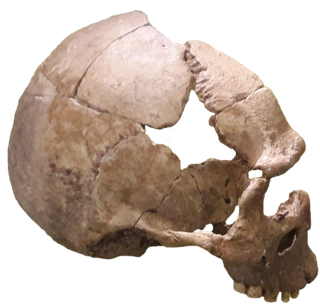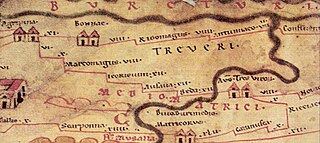
Westphalia is a region in northwestern Germany and one of the three historic parts of the state of North Rhine-Westphalia. It has an area of 20,208 km2 (7,802 sq mi) and 7.9 million inhabitants.

The County of Mark was a county and state of the Holy Roman Empire in the Lower Rhenish–Westphalian Circle. It lay on both sides of the Ruhr river along the Volme and Lenne rivers.

The Rhine-Ruhr metropolitan region is the largest metropolitan region in Germany with over 10 million inhabitants. It is of polycentric nature. It covers an area of 7,268 square kilometres (2,806 sq mi) and lies entirely within the federal state of North Rhine-Westphalia. The Rhine-Ruhr metropolitan region spreads from Dortmund-Bochum-Essen-Duisburg in the north, to the urban areas of the cities of Mönchengladbach, Düsseldorf, Wuppertal, Leverkusen, Cologne, and Bonn in the south. The location of the Rhine-Ruhr at the heart of the European blue banana makes it well connected to other major European cities and metropolitan areas like the Randstad, the Flemish Diamond and the Frankfurt Rhine Main Region.

Barntrup is a town in the Lippe district of North Rhine-Westphalia, Germany. It has an area of 59.46 km² and 8,824 inhabitants (2013). It lies 40 km east from Bielefeld and 9 km west from Bad Pyrmont at the east border of NRW to Lower Saxony.

Blankenstein Castle is a castle located on the south side of the river Ruhr in Hattingen, North Rhine-Westphalia, Germany.

Bladenhorst Castle is a moated castle in the suburbs of the city of Castrop-Rauxel.
The Minden Museum Railway or MEM was founded in 1977 as a society. Its aim was to preserve historic railway vehicles and operate them on the Minden District Railway. It was not long before the first museum train worked the line. The museum's vehicles were initially housed in the coach hall of the MKB's old locomotive depot (Bahnbetriebswerk) at Minden Stadt station.

SPD Nordrhein-Westfalen is a political party in German state North Rhine-Westphalia and is, with 136,840 members, the biggest state group of Social Democratic Party of Germany (SPD). The chairman is Michael Groschek and the secretary general is Svenja Schulze.

The North Rhine-Westphalia state election, 2012 was a snap election held on 13 May 2012, to elect members to the Landtag of the German state of North Rhine-Westphalia, after the former Landtag was dissolved on 14 March 2012. The red-green minority government led by Minister-President Hannelore Kraft was returned with a 19-seat majority and were able to continue governing the state.

The Rhine romanticism was the interpretation of the landscape conditions and history of the Rhine Valley in the cultural-historical period of the romanticism, by the end of the 18th century until the late 19th century and was continued in all forms of art expression.

Theater Münster is a municipal theatre in Münster, North Rhine-Westphalia, Germany, for plays and music theatre. When it opened in 1956 it was regarded as the first new theatre building in Germany after World War II. It integrates some ruins of the former theatre and musical school destroyed in the war.
The Rudolf Virchow lecture was an annual public lecture delivered by an eminent researcher in the field of Palaeolithic archaeology in Neuwied (Germany). The lecture was held in honour of the German physician, archaeologist and politician Rudolf Virchow and his contributions to German archaeology, whilst at the same time also honouring the outstanding accomplishments of the invited speaker. The lecture series was discontinued after 2016, when a new price, THE HUMAN ROOTS AWARD was established to recognise significant achievements that have had an outstanding impact or great influence in understanding the archaeology of human behavioural evolution.

The archaeological site Niederbieber is an important representative of the Federmesser culture. Dating to the end of the Pleistocene, the site is one of the most extensively excavated archaeological sites dating to the late Upper Palaeolithic. Finds and features are extraordinarily well preserved as the site was protected by fallout from the Laacher See volcanic eruption approximately 12,900 years ago. Comprehensive archaeological studies have provided a detailed view of activities and settlement dynamics of hunter-gatherer groups at the end of the ice age.

Monrepos is an archaeological research centre and a museum for the human behavioural evolution located at Schloss Monrepos in Neuwied. On the one hand, the development of our modern human behaviour in the Palaeolithic and Mesolithic is studied at the research centre and on the other hand, the findings of these studies are conveyed to the public in the museum. Monrepos is one of the leading institutions for the research of early human history.

The Rhünda Skull is a fossil human skull that was found just outside the village of Rhünda in North Hesse, Germany. It is dated to the Magdalenian, about 12,000 years old.

The Roman road from Trier to Cologne is part of the Via Agrippa, a Roman era long distance road network, that began at Lyon. The section from Augusta Treverorum (Trier) to the CCAA (Cologne), the capital of the Roman province of Germania Inferior, had a length of 66 Roman leagues. It is described in the Itinerarium Antonini, the itinerarium by Emperor Caracalla (198–217), which was revised in the 3rd century, and portrayed in the Tabula Peutingeriana or Peutinger Table, the Roman map of the world discovered in the 16th century, which shows the Roman road network of the 4th century.

Rheindahlen is a town in the western and largest borough of the city of Mönchengladbach in the German state of North Rhine-Westphalia. Since the reorganisation of Monchengladbach's boroughs (Stadtbezirke) on 22 October 2009 Rheindahlen has been part of Mönchengladbach West. From the granting of Nideggen town rights in 1354 until the incorporation of the mayoralty of Rheindahlen into M.-Gladbach on 30 June 1921, the place was an independent town.
The Main Limes, also called the Nasser Limes, was built around 90 A. D. and, as part of the Upper Germanic-Rhaetian Limes, formed the frontier of the Roman Empire in the area between the present day villages of Großkrotzenburg and Bürgstadt. In this section the limes adjoined the River Main (Moenus), which forms a natural boundary for about 50 kilometres here, so "Main" refers to the river.
















